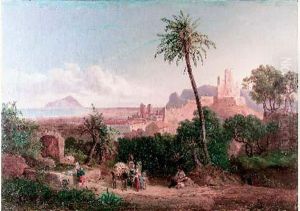Karl-Wilhem Gotzloff Paintings
Karl-Wilhelm Götzloff, born in 1799, was a German painter associated with the Düsseldorf school of painting, though his work also exhibits qualities of Romanticism and the Biedermeier period. He was known for his landscapes, marine paintings, and architectural scenes, which often reflected a detailed observation of nature and a fascination with light and atmosphere, hallmarks of the Romantic sensibility.
Götzloff initially studied at the Dresden Academy of Fine Arts under the guidance of landscape painter Christian Wilhelm Ernst Dietrich, known as Dietricy. His early works were influenced by the 17th-century Dutch landscape tradition, which was characterized by a high level of detail and a focus on the effects of light and shadow.
In the 1820s, he traveled extensively throughout Europe, including Italy, where he was profoundly influenced by the Italian landscape and the work of the Old Masters. During his time in Italy, Götzloff was part of the circle of German artists residing in Rome, known as the 'Deutschrömer'. The light and color of the Mediterranean greatly impacted his painting style, leading to the creation of works that featured Italian scenery and historic sites, imbued with a sense of warmth and clarity.
Götzloff returned to Germany in 1836 and became a member of the Dresden Academy. Throughout his career, he exhibited his works in Dresden and Berlin, gaining recognition for his artistic contributions. His paintings were appreciated for their ability to capture the essence of the landscapes and cityscapes he portrayed, blending realistic detail with a romanticized vision.
Although not as widely known today as some of his contemporaries, Götzloff's work remains an example of the transition from the neoclassical approach to the more emotive and picturesque tendencies of the 19th century. He died in 1866, leaving behind a legacy of work that continues to be of interest to scholars studying the Düsseldorf school and the broader Romantic movement in European art.
